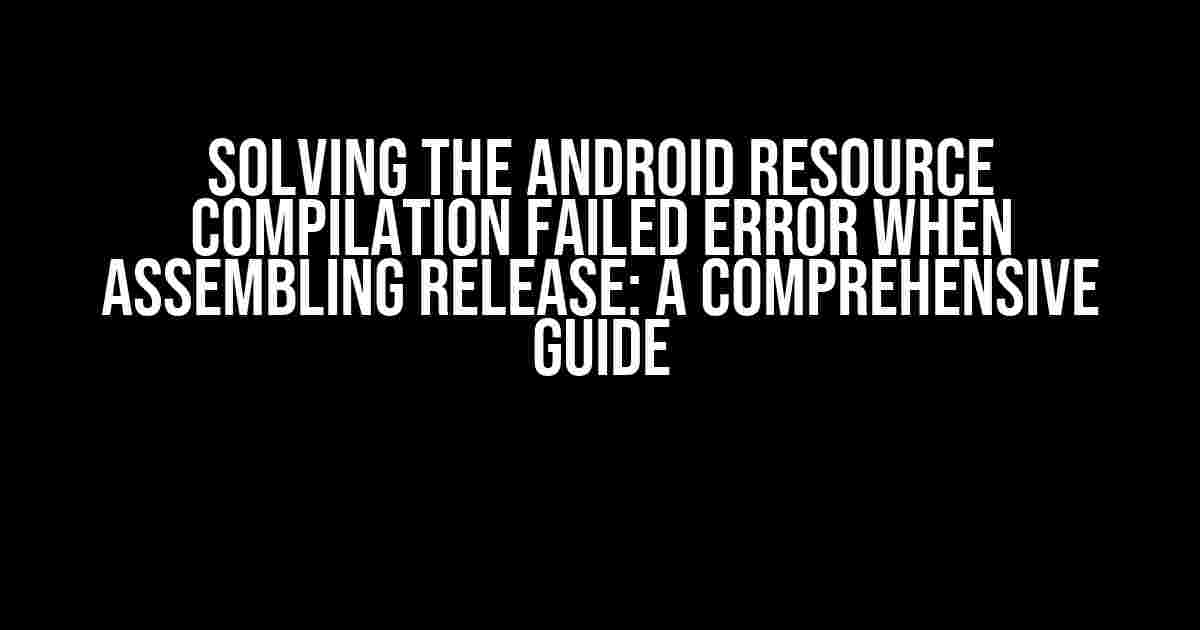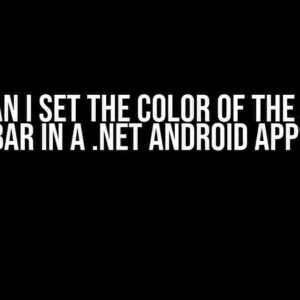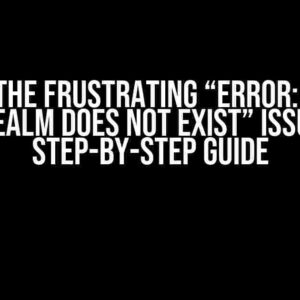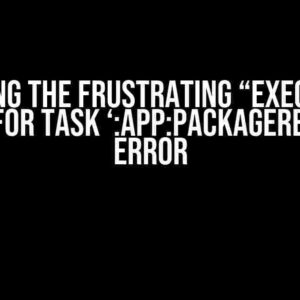Ah, the infamous “Android resource compilation failed” error when assembling a release build. It’s a frustrating issue that can bring your development process to a grinding halt. But fear not, dear developer! In this article, we’ll delve into the possible causes of this error and provide step-by-step solutions to help you overcome it.
- What is the Android Resource Compilation Failed Error?
- Solutions to the Android Resource Compilation Failed Error
- 1. Verify Resource File Names and IDs
- 2. Review Resource Files for Mismatched or Missing Attributes
- 3. Remove Duplicated Resource Names or IDs
- 4. Validate Resource Files for Syntax Errors or Corruption
- 5. Resolve Dependency Issues or Conflicts
- 6. Invalidate Caches and Restart Android Studio
- 7. Clean and Rebuild the Project
- 8. Check for Gradle Issues or Conflicts
- Advanced Troubleshooting Techniques
- Conclusion
What is the Android Resource Compilation Failed Error?
The “Android resource compilation failed” error occurs when the Android build process encounters an issue while compiling the resources (such as layouts, strings, and drawables) in your project. This error typically manifests during the assembleRelease stage, which is responsible for building the APK or AAB file for release.
Common Causes of the Error
Before we dive into the solutions, it’s essential to understand the common causes of the “Android resource compilation failed” error:
- Typo in resource file names or IDs: A simple typo in a resource file name or ID can cause the compilation process to fail.
- Mismatched or missing attributes in resource files: Failing to provide required attributes or specifying incorrect values can lead to compilation errors.
- Duplicated resource names or IDs: Having duplicate resource names or IDs can cause conflicts and compilation errors.
- Invalid or corrupted resource files: Resource files with syntax errors or corruption can prevent compilation.
- Dependency issues or conflicts: Incompatibilities or conflicts between dependencies can cause compilation errors.
- Gradle or Android Studio issues: Problems with Gradle or Android Studio can also lead to the compilation failed error.
Solutions to the Android Resource Compilation Failed Error
Now that we’ve covered the common causes, let’s move on to the solutions:
1. Verify Resource File Names and IDs
Double-check all your resource file names and IDs to ensure they are correct and consistent:
<resources>
<string name="app_name">My App</string>
<!-- Ensure the ID is correct and consistent throughout the project -->
</resources>
2. Review Resource Files for Mismatched or Missing Attributes
Verify that all resource files have the required attributes and that they are correctly specified:
<resources>
<style name="AppTheme" parent="Theme.AppCompat.Light.DarkActionBar">
<!-- Ensure all required attributes are present and correct -->
<item name="colorPrimary">@color/colorPrimary</item>
<item name="colorPrimaryDark">@color/colorPrimaryDark</item>
<item name="colorAccent">@color/colorAccent</item>
</style>
</resources>
3. Remove Duplicated Resource Names or IDs
Ensure that there are no duplicate resource names or IDs in your project:
<resources>
<string name="app_name">My App</string>
<!-- Remove duplicated resource names or IDs -->
<string name="app_name">My App Duplicate</string>
</resources>
4. Validate Resource Files for Syntax Errors or Corruption
Check all resource files for syntax errors or corruption:
<resources>
<string name="app_name">My App</string>
<!-- Ensure the XML is well-formed and valid -->
</resources>
5. Resolve Dependency Issues or Conflicts
Verify that all dependencies are compatible and up-to-date:
dependencies {
implementation 'com.android.volley:volley:1.1.1'
implementation 'com.squareup.picasso:picasso:2.71828'
<!-- Ensure dependencies are compatible and up-to-date -->
}
6. Invalidate Caches and Restart Android Studio
Try invalidating caches and restarting Android Studio to resolve any temporary issues:
File > Invalidate Caches / Restart
7. Clean and Rebuild the Project
Clean and rebuild the project to remove any temporary files or compilation artifacts:
Build > Clean Project Build > Rebuild Project
8. Check for Gradle Issues or Conflicts
Verify that Gradle is configured correctly and that there are no conflicts:
apply plugin: 'com.android.application'
android {
compileSdkVersion 29
buildToolsVersion "29.0.3"
<!-- Ensure Gradle configuration is correct and consistent -->
}
Advanced Troubleshooting Techniques
If the above solutions don’t resolve the issue, it’s time to dig deeper:
1. Enable Gradle Verbosity
Enable Gradle verbosity to get more detailed compilation errors:
org.gradle.jvmargs=-Xmx4096m -XX:MaxPermSize=1024m -XX:+HeapDumpOnOutOfMemoryError -Dorg.gradle.vfs.watch=true -Dfile.encoding=UTF-8 -Dorg.gradle.daemon=true
2. Analyze the Compilation Error Message
Study the compilation error message to identify the specific issue:
Android resource compilation failed Output: C:\...\res\values\styles.xml:24: error: resource symbol #0x7f0c0083 not found ...
3. Use the Android Resource Compiler (AAPT)
Utilize the Android Resource Compiler (AAPT) to manually compile resources:
aapt compile --dir res/ -o compiled-res.ap_
4. Review the Project Structure and Configuration
Verify that the project structure and configuration are correct and consistent:
MyApp/ app/ src/ main/ AndroidManifest.xml res/ values/ strings.xml styles.xml ... ...
Conclusion
The “Android resource compilation failed” error when assembling a release build can be frustrating, but by following these solutions and advanced troubleshooting techniques, you should be able to identify and resolve the root cause of the issue. Remember to be patient, methodical, and meticulous in your approach, and don’t hesitate to seek help if you’re still stuck.
By mastering the art of resource compilation and troubleshooting, you’ll be well on your way to delivering high-quality Android apps that delight users and make you proud.
| Common Causes | Solutions |
|---|---|
| Typo in resource file names or IDs | Verify resource file names and IDs |
| Mismatched or missing attributes in resource files | Review resource files for attributes |
| Duplicated resource names or IDs | Remove duplicated resource names or IDs |
| Invalid or corrupted resource files | Validate resource files for syntax errors or corruption |
| Dependency issues or conflicts | Resolve dependency issues or conflicts |
| Gradle or Android Studio issues | Invalidate caches, clean, and rebuild project |
Note: This article is optimized for the keyword “Android resource compilation failed error when assembling Release” and is written in a creative tone to engage developers and provide clear instructions for resolving the issue.
Frequently Asked Question
Assembling a release can be a daunting task, and sometimes, you might encounter the frustrating “Android resource compilation failed” error. Fear not, dear developer, for we’ve got the answers to your burning questions!
What does “Android resource compilation failed” error mean?
This error occurs when the Android build system fails to compile the app’s resources, such as layouts, drawables, or values. It’s usually caused by a syntax error, invalid file name, or mismatched configuration. Don’t worry, we’ll help you troubleshoot it!
How do I find the root cause of the error?
To identify the issue, check the Gradle console output for more detailed error messages. You can also try analyzing the build log or checking the resource compilation logs to pinpoint the problematic file or configuration.
What’s the deal with the “AAPT: error: attribute ‘***’ not found” error?
This error typically occurs when there’s a missing or incorrect attribute in your resource file (e.g., layout.xml or styles.xml). Double-check your XML files for typos, invalid attributes, or incorrect namespace declarations.
How can I fix the “Android resource compilation failed” error due to a missing theme attribute?
Easy fix! Just add the missing theme attribute to your AndroidManifest.xml file or the affected resource file. Make sure to include the correct namespace and attribute name.
What if I’ve tried everything and still can’t resolve the error?
Don’t give up! Try cleaning and rebuilding your project, invalidating the cache and restarting Android Studio, or seeking help from online communities, such as the Android Developers forum or Stack Overflow. You can also try deleting the `.gradle` directory and rebuilding the project.





